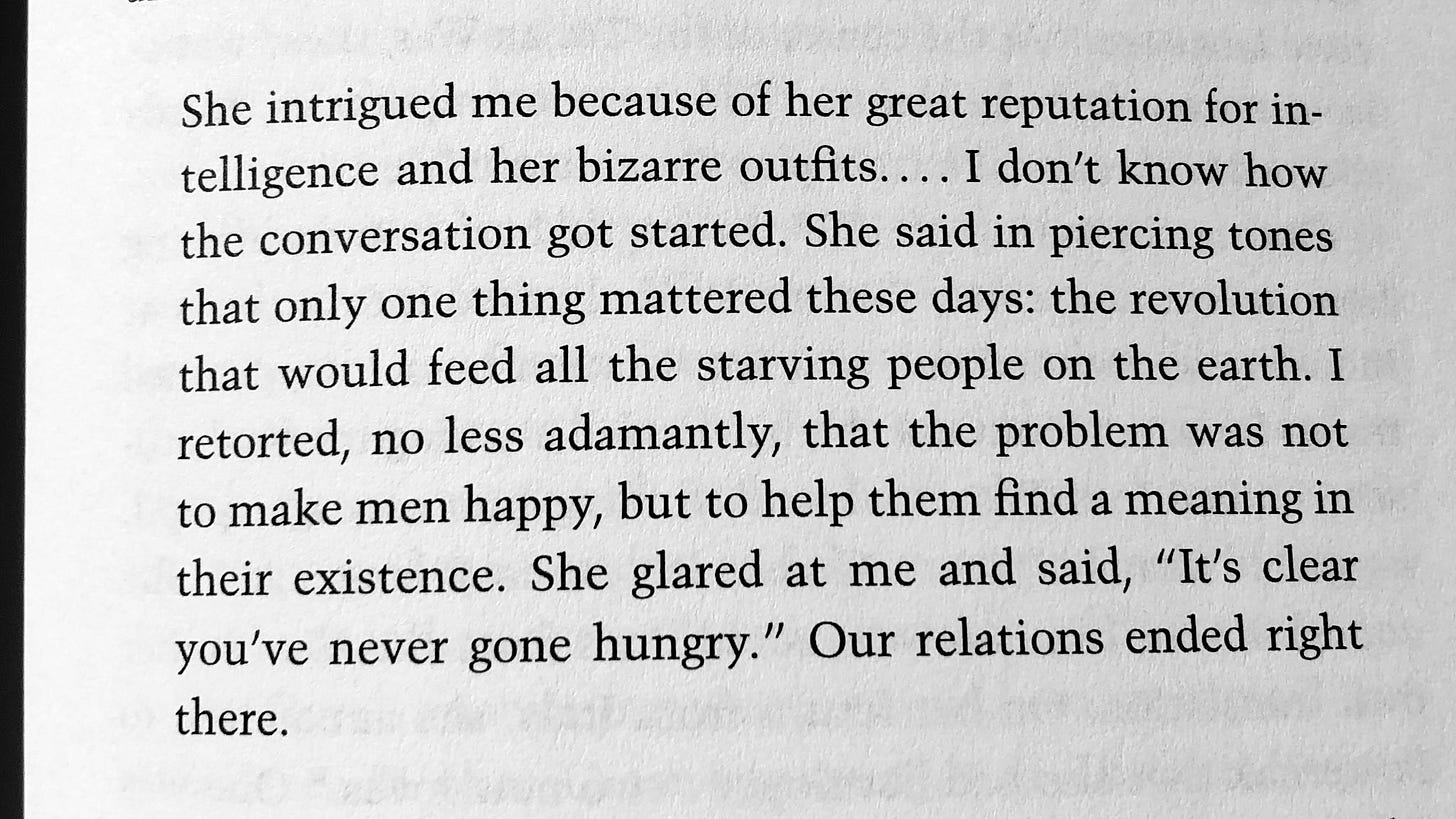On Friday my friends took me impromptu to see this film, and I came out of it blissed out by what I experienced as a stunning subversive satire. I find it impossible to believe this CGI-abusive, overstuffed radioactive turkey of a film could be read earnestly, and yet Coppola seems to have been going for a genuine Randian superhero narrative, according to Wikipedia’s brief Themes section. How could that be the aim when you have such a devastating comedic sequence like the following, which targets male genius so concisely?
Cesar Catilina: “And you think one year of... medical school entitles you to plow through the riches of my Emersonian mind?
Julia Cicero: Entitles me?
Cesar Catilina: Yes.
Julia Cicero: [scoffs] Entitles me?
Cesar Catilina: Yeees!
Julia Cicero: Entitles me?
Cesar Catilina: YEEEEEES!
Julia Cicero: You have no idea about me! You think I am nothing, just a socialite?
Cesar Catilina: No, not nothing, but I reserve my time for people who can think. About science. And literature, and... architecture and art. You find me cruel, selfish and unfeeling? I am. I work without caring what happens to either of us. So go back to the cluuuub, bear it all, and stalk the kind of people that you enjoy.
I’m sorry, but how could one read “Emersonian mind” and not see Catilina as a clear parody of a lineage of Marvel/DC superheroes (notably Batman), as well as today’s cult-of-personality autist billlionaires a la Musk and Zuckerberg? And yet every reviewer harangued the film for its ridiculous dialogue and chaotic scenery, as if this was really a traditional dystopic tale about one misunderstood man’s quest for a hopeful future, with himself as a vanguard against pessimist politicians. Brian Tallerico says it has a “relatively traditional story” and lambasts: “It is foundationally unsound at times, feeling almost like something went wrong in the edit or Coppola didn’t shoot the scenes he needed to connect his ideas.” This, to me, is the most boring way to view this film’s rampant, campy leakages. Why try to stuff this film back into an earnest American hero’s journey when it’s bursting with reified extremes of the genre’s tropes, as well as not-so-subtle references to the actual (and sad) history of the construction of public “leisure” spaces?
Tallerico complains about the populist riot arc which is built up and then spontaneously abandoned, etc…. when in my brain I read this plot as totally intentional as a critique of real-life Megalopolis-like projects by ego-slutty billionaires. There’s scenes where immigrant families are literally tearing at the gates of Megalopolis, babies crying, and screaming about losing their homes, and Catilina just waxes aphoric about love, quoting Siddhartha, Thoreau, etc. Megalopolis itself doesn’t seem to have any clear purpose or even magical function. All that is demonstrated is an etherealised horizontal escalator, which makes me think that the Megalopolis structure is basically like if Central Park was replaced with an outdoor version of the Singapore airport. As well, Catilina has invented Megalon, a material that can literally do anything, and the only thing he uses it for is to fix his own face and create these gravity-defying escalators. Catilina’s plan is literally to save the world through a luminated array of shapes and colors. Megalopolis puts the pre-2008 American Dream through a 2CB-like tantric threshold, and in the process, breaks it in one beautiful phantasmic shatter.
We see Megalopolis’s every day. I lived in Tottenham Hale, a Zone 3 “developing area” of London, for 2 years as a resident of a student accommodation in a new build that would remind the onlooker of a Scandinavian prison. Throughout those 2 years, I witnessed at least 7 new building projects pop up around me. There was not a day where I would'n’t wake up to the sound of drills. Right now, the newest thing is the “Heart of Hale” project right across from the Tube station which promises a “vibrant future” with a new “central public square”. Just across from this development sit homeless people with their dogs, begging for money from students who pass out of the station on their way home. One can also think of the actual Central Park and the eviction of the immigrant-dominant community of Seneca Village in the mid-1800s that had to happen to make way for a park that was pushed for by the city’s elites. Or, of abandoned/outdated public structures like the Battersea Power Station, which have now just been turned into tourist attractions-qua-malls. Me and my friend reserved a day a couple years ago to go see BPS because we had thought, from hearing of its development and seeing photos of the interior, that it would be an artisan-centric market type place… imagine the shock of banality when we walked in to see Pret and Starbucks flanking us on either side of the entrance. I couldn’t help but Megalopolis as a satirical real estate commercial, as the mantra-centric Super Bowl advertisement medium taken to a jouissance.

There’s also other random plot lines which are camptastically brilliant, but I’d like to especially note the “icy, antihero male protag has dead wife trauma which is inexplicably connected with his quest as a hero” trope which was treated so well here. Every time Catilina would think about her, it would show the same clip of her looking back at the camera with a cheeky lens-flare… just this year I saw this same trope done earnestly in La Chimera, which, in my opinion, only took away from the plot’s charm and the potential for a complex male protag. But in Megalopolis, the fact that her murder is a focal point for like 5 minutes and then completely sidetracked and forgotten about — as well as her absurdly pale, on-the-nose ghostlike visage in her closeups — makes it a little bit hilarious. The generic grief is just so perfect… the imperceptible wisp that she is turns her into the ghost-like Grimes to Catilina’s Elon like persona.
I’d also like to slopatopolis whoever directed the CGI for this film — it was truly like nothing I’ve ever seen before, and couldn’t imagine anything like this would ever be used in a feature. It recalled old Soviet space cartoons like The Mystery of the Third Planet (1981), real estate advertisements on the tube for Croydon, the toy sets in pediatric doctors’ waiting rooms, and also the aesthetic of late 2000/early 2010’s digital interfaces that has been coined as “frutiger aero”. Laura Holliday summarizes frutiger aero in this piece for Dazed:
“While UI design is where frutiger aero originated, droplets of it can be seen all over the late 00s and early 10s, with its bubbly branding travelling as far afield as air conditioner vents, laundry detergents, and even frozen yoghurt shop chairs. Frutiger aero can be seen in the shimmery facial features of the Sims 3 characters, the lobes of an Xbox 360 controller, the slash of a Fruit Ninja watermelon on a faux-wooden chopping board.”
Megalopolis’s visual identity was slashed for its gloss and its glow, but I would argue that, if you read the film as I did, these excesses make perfect sense for the worldbuilding. They pay homage to this lost era in which digitality seemed to have hydrational properties, in which the informational sublime could be a hyaluronic high through which to escape from the everyday. In the tumult of a post-Covid online ecosystem in which we are learning to play all over again, but through the discord of images rather than their sheen. I.e., the parodization of frutiger aero through the dolphin pic meme:
The frutiger aero of Megalopolis works so many wonders. The impossible physics that hold together bedroom interiors and architectural models render Catilina’s message as a clear absurdity (at least to me) by equating it with lost retro visions, for one. The aesthetic also pokes fun at the rising issue of AI art — for example, in the scene where images of Megalopolis with small figures in the foreground generate over and over again, faster and faster, until their utopia appears toneless. It also is just, quite frankly, beautiful, and far more beautiful than a CGI that attempts total realism. I loved the shot of the well-lit flower stand, iridescing in the midst of the dark like a blooming island, that Catilina visits to buy flowers for the dead wife. It recalls the flower stands and kiosks that are open in Hong Kong 24/7. In general, a lot of this genre of CGI kitsch recalls the real contrast you see in Asian cities between high-life shiny malls and complexes, with idyllic indoor gardens offset by the soft buzz of ascendant escalators, and the drab poverty that just under the bridge or around the bend.
I struggle to believe that Coppola could’ve done all this by accident or by mistake in a strive for the supposedly intended transcendental narrative. Maybe it was in his subconscious or something. Megalopolis, to me, is a delicious scattering of the vulturous nature of pure, picturesque capital. It’s PR for PR, it’s a pregnant flower the size of a beast. To be inhaled with a Nebuchadnezzar size Moët and radioactive seafood from the Hudson River.
I’ll leave you with this quote from Simone De Beauvoir’s diary about meeting Simone Weil. Make of it what you will.







Thank you for this. A great analysis.